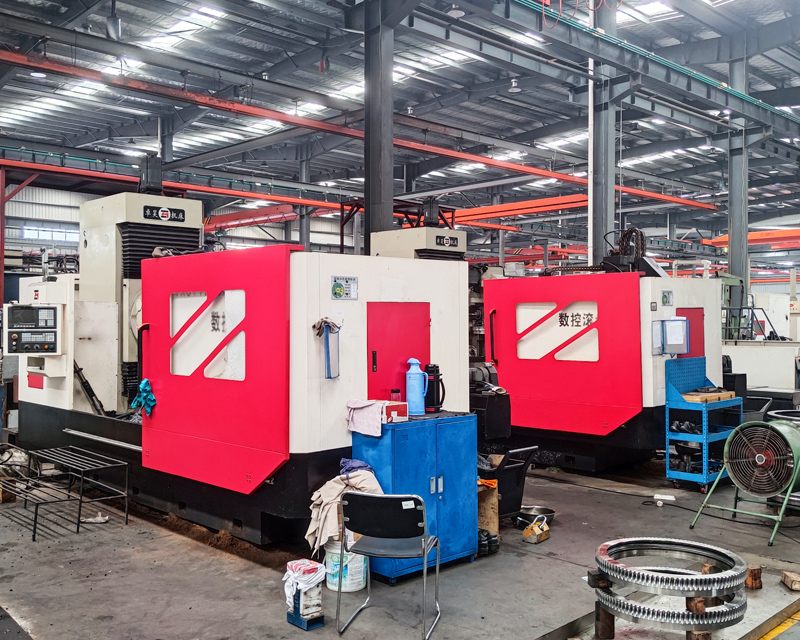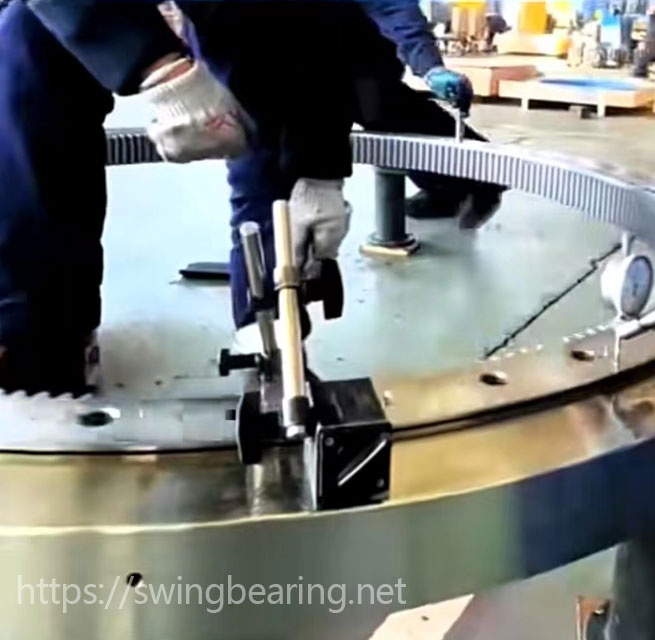
A failing swing bearing in a CAT 329D 227-6087 excavator can cause a variety of symptoms that may indicate the need for maintenance or replacement. The swing bearing is a crucial component of the excavator’s swing mechanism, which allows the machine to rotate and pivot while in operation. When this bearing begins to fail, it can lead to a range of issues that may impact the performance and stability of the excavator. Some of the typical symptoms of a failing swing bearing in a CAT 329D 227-6087 include:
1. Excessive noise: One of the most common signs of a failing swing bearing is an increase in noise levels while the excavator is in operation. This noise may be described as grinding, squeaking, or rumbling, and it can become more pronounced as the bearing wears down further.
2. Reduced performance: A failing swing bearing can cause the excavator to become less responsive and less stable during operation. This may result in difficulty maneuvering the machine or maintaining a consistent digging or lifting force.
3. Vibrations: As the swing bearing deteriorates, it may cause increased vibrations throughout the excavator’s structure. These vibrations can be felt by the operator and may also be visible as shaking or wobbling in the machine’s movement.
4. Leaking oil: A failing swing bearing may also cause oil to leak from the bearing housing. This can result in a buildup of oil on the ground or other components of the excavator, which may require cleaning and can potentially lead to slippery conditions.
5. Difficulty in rotation: As the swing bearing fails, it may become more difficult for the excavator to rotate smoothly. This can result in jerky or uneven movement, which may be particularly noticeable when the machine is attempting to make tight turns or pivot quickly.
If you suspect that your CAT 329D 227-6087 excavator is experiencing issues with its swing bearing, it is important to have the machine inspected by a qualified technician as soon as possible. Regular maintenance and timely replacement of worn or damaged components can help to prevent more serious problems and extend the life of your excavator.
A swing bearing is a crucial component in a CAT 329D 227-6087 excavator, responsible for supporting the movement of the machine’s boom and arm. Over time, the swing bearing can wear out and fail, leading to a decline in the excavator’s performance and potential damage to the machine. In this article, we will discuss the typical symptoms of a failing swing bearing in a CAT 329D 227-6087, helping you identify the warning signs and take appropriate action.
One of the first signs of a failing swing bearing is an increase in noise levels. As the bearing wears down, it can produce a grinding or scraping sound when the excavator is in operation. This noise may become more pronounced as the bearing deteriorates further, indicating that it is time for a replacement.
Another symptom of a failing swing bearing is a decrease in the excavator’s overall performance. As the bearing wears out, it may become less effective at supporting the movement of the boom and arm, leading to reduced stability and control. This can make it difficult to perform tasks such as digging and lifting, and may result in a decline in the excavator’s productivity.
A third warning sign of a failing swing bearing is excessive play or movement in the excavator’s boom and arm. As the bearing wears down, it may no longer provide the necessary support to keep the boom and arm in place, resulting in increased movement and instability. This can be particularly dangerous when operating the excavator at height or when lifting heavy loads, as it may lead to accidents and damage to the machine.
In addition to these symptoms, a failing swing bearing may also cause the excavator to become more difficult to maneuver. As the bearing wears out, it may become less effective at transferring the load from the boom and arm to the excavator’s chassis, resulting in a loss of power and control. This can make it more challenging to operate the machine, particularly in tight spaces or when performing intricate tasks.
If you suspect that your CAT 329D 227-6087 excavator is experiencing swing bearing failure, it is important to take action as soon as possible. Ignoring the warning signs can lead to further damage to the machine and potential safety hazards. To diagnose a failing swing bearing, it is recommended that you consult with a qualified mechanic or technician who is familiar with CAT excavators. They will be able to inspect the swing bearing and determine if it needs to be replaced.
In conclusion, identifying the warning signs of a failing swing bearing in a CAT 329D 227-6087 is crucial for maintaining the machine’s performance and ensuring safety during operation. By being aware of the typical symptoms, such as increased noise levels, decreased performance, excessive play, and difficulty maneuvering, you can take appropriate action to address the issue and prevent further damage to the excavator. Remember, if you suspect that your swing bearing is failing, it is important to consult with a qualified professional to diagnose and resolve the issue.
The CAT 329D 227-6087 is a powerful and versatile excavator, designed to handle a wide range of tasks in various industries. However, like any other machine, it is susceptible to wear and tear, and one of the critical components that may fail over time is the swing bearing. In this article, we will discuss the typical symptoms of a failing swing bearing in a CAT 329D 227-6087 and the importance of regular maintenance in preventing such failures.
A swing bearing is a crucial component of an excavator’s undercarriage, responsible for supporting the weight of the machine and allowing it to rotate smoothly. Over time, the swing bearing can wear out due to constant use, leading to a decline in its performance and, eventually, failure.
The first symptom of a failing swing bearing is an unusual noise. As the bearing wears down, it may produce grinding, squeaking, or rumbling sounds when the excavator is in operation. These noises can be an indication that the bearing is not functioning correctly and may require immediate attention.
Another symptom of a failing swing bearing is excessive play or movement in the excavator’s boom and arm. As the bearing wears, it may lose its ability to hold the boom and arm securely in place, causing them to move or wobble when the machine is in operation. This can lead to a loss of control and reduced stability, making it difficult for the operator to perform tasks effectively.
A third symptom of a failing swing bearing is difficulty in rotating the excavator. As the bearing wears, it may become more challenging to turn the machine smoothly, causing it to stick or become stiff. This can make it difficult for the operator to maneuver the excavator and may lead to reduced productivity.
Lastly, a failing swing bearing may cause vibrations in the excavator’s cab. As the bearing wears, it may not be able to distribute the machine’s weight evenly, leading to an uneven distribution of forces and vibrations. This can be uncomfortable for the operator and may also indicate a more severe problem with the swing bearing.
Regular maintenance is essential in preventing swing bearing failure in a CAT 329D 227-6087. Owners should schedule routine inspections and lubrication of the swing bearing to ensure that it remains in good working condition. During these inspections, it is crucial to check for any signs of wear or damage, such as cracks, chips, or excessive play. If any issues are detected, they should be addressed promptly to prevent further deterioration of the swing bearing.
In addition to regular maintenance, owners should also be vigilant in monitoring the excavator for any unusual symptoms, such as noise, vibration, or difficulty in rotating. If any of these symptoms are present, it is essential to consult with a qualified technician to diagnose and address the issue before it leads to a more severe problem.
In conclusion, a failing swing bearing in a CAT 329D 227-6087 can cause significant issues for the machine’s performance and stability. By being aware of the typical symptoms of a failing swing bearing and implementing regular maintenance practices, owners can prevent such failures and ensure that their excavator remains in optimal working condition.
A swing bearing is a crucial component in the operation of a CAT 329D 227-6087 excavator. It is responsible for allowing the machine’s boom and arm to pivot smoothly, enabling the excavator to perform various tasks such as digging, lifting, and grading. However, when a swing bearing begins to fail, it can significantly impact the excavator’s performance and even lead to costly repairs or replacements. In this article, we will discuss the typical symptoms of a failing swing bearing in a CAT 329D 227-6087 and provide some solutions to address these issues.
One of the first signs of a failing swing bearing is excessive noise. As the bearing wears down, it can produce a grinding or scraping sound when the excavator is in operation. This noise is often more pronounced when the machine is making sharp turns or performing tasks that require the boom and arm to pivot frequently. If you notice an unusual amount of noise coming from your excavator’s swing bearing, it is essential to address the issue promptly to prevent further damage.
Another common symptom of a failing swing bearing is reduced performance. As the bearing wears down, it can cause the excavator’s boom and arm to become less responsive and more difficult to control. This can make it challenging to perform tasks that require precise movement, such as grading or digging in tight spaces. Additionally, a failing swing bearing can cause the excavator to become less stable, increasing the risk of accidents and injuries.
A third symptom of a failing swing bearing is excessive play or movement in the pivot point. As the bearing wears down, it can allow more movement between the boom and arm, which can lead to a loose or unstable feel when operating the excavator. This excessive play can also cause the excavator to become less efficient, as it requires more energy to perform tasks.
To address these issues, it is essential to perform regular maintenance on your CAT 329D 227-6087’s swing bearing. This includes regularly inspecting the bearing for signs of wear and tear, such as cracks, chips, or excessive play. If you notice any of these signs, it is essential to replace the bearing as soon as possible to prevent further damage. Additionally, it is crucial to lubricate the swing bearing regularly, as this can help to reduce friction and wear, extending the life of the bearing.
In some cases, it may be necessary to replace the entire swing bearing assembly. This can be a complex and time-consuming process, requiring specialized tools and equipment. However, it is essential to ensure that the swing bearing is replaced correctly to prevent further issues down the line.
In conclusion, a failing swing bearing in a CAT 329D 227-6087 can cause a range of issues, from excessive noise and reduced performance to instability and accidents. By regularly inspecting and maintaining the swing bearing, you can help to prevent these issues and keep your excavator operating smoothly and efficiently. If you suspect that your excavator’s swing bearing is failing, it is essential to address the issue promptly to prevent further damage and ensure the safety of your operators.
